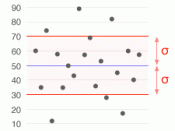One main reason for the difference between the mean growth rate and standard deviation calculated using old method (deferred revenue) and new method (adjusted for deferred revenue) is that deferred revenue method enable the smoothing of the revenues whereas the adjusted revenue method nullifies this advantage. Also, for the same reason, adjusted method increases the volatility of the growth rate. For instance, when recognizing all revenue (adjusted growth), the mean growth rate of 38% and standard deviation growth rate of 20% is much higher than the reported mean growth rate of 35% and reported standard deviation 14%, which includes deferred revenue element.
When a product is released, sales growth is initially high. This is illustrated by adjusted growth starting at 88% in 1st quarter of 1996 and decreasing to 27% in 4th quarter of 1999. However, Microsoft adopted a policy that deferred revenues. Therefore, the high reported growth in beginning periods were postponed to later periods.
This is evident by the lower mean and standard deviation of the reporting revenue growth.
For the reporting revenue, Microsoft consistently deferred 20% of windows operating systems and associated products. This caused revenue to have less fluctuation from the mean over time, which was illustrated with a lower standard deviation. By having less volatility, the deferred revenue smoothed reported growth.
Microsoft has always adopted conservative accounting policies. Furthermore, based on SOP 97-2, "software revenue [can] be deferred when the software arrangement consisted of "multiple affects." For external reporting reasons, since windows 95 started Microsoft's effort to integrate its various products and since the company projected receiving revenue from these products over their lifetime (20% of the expected total revenue from the product), the company decided to implement ratable revenue recognition policyMicrosoft developed a new product (Window 95) in first quarter of fiscal...


